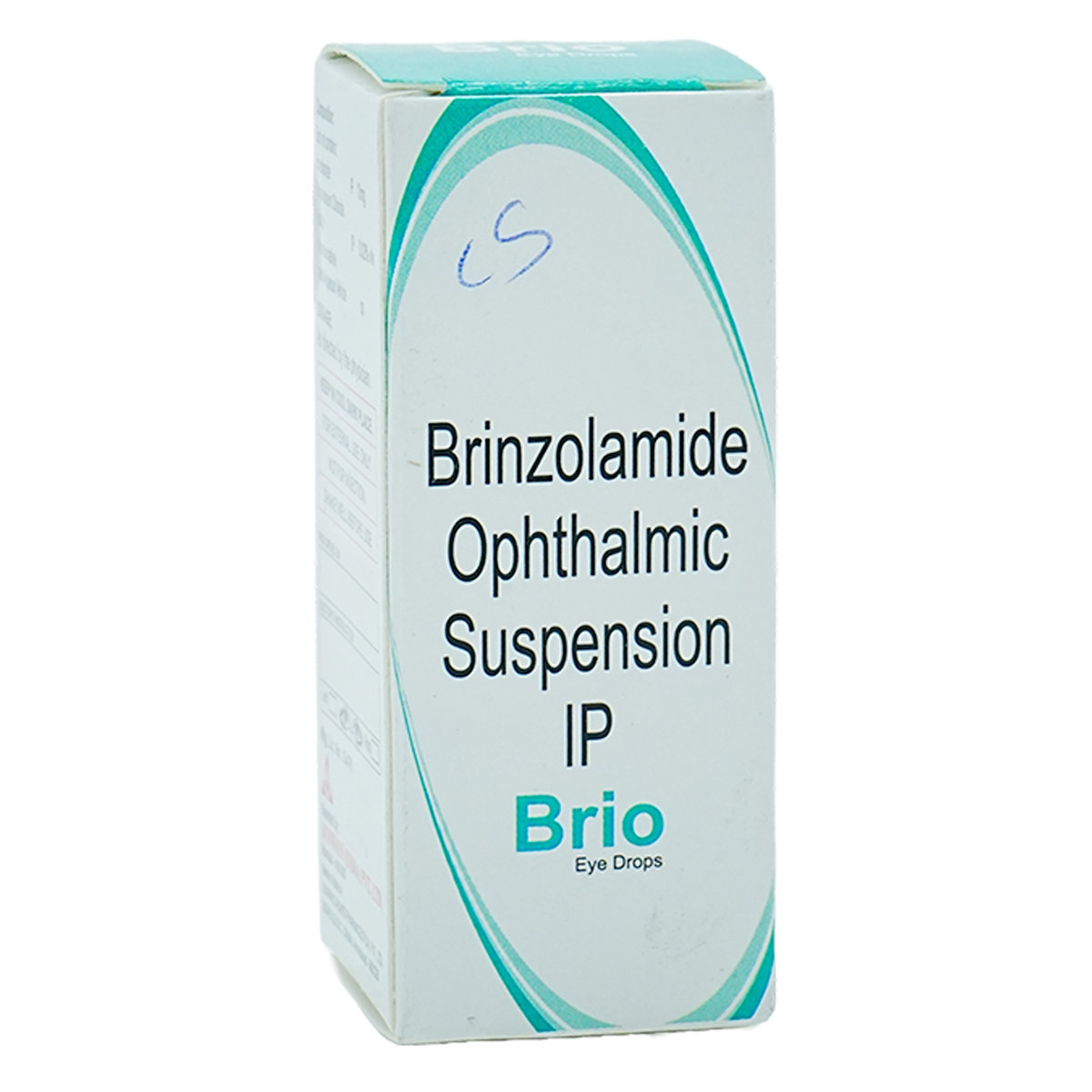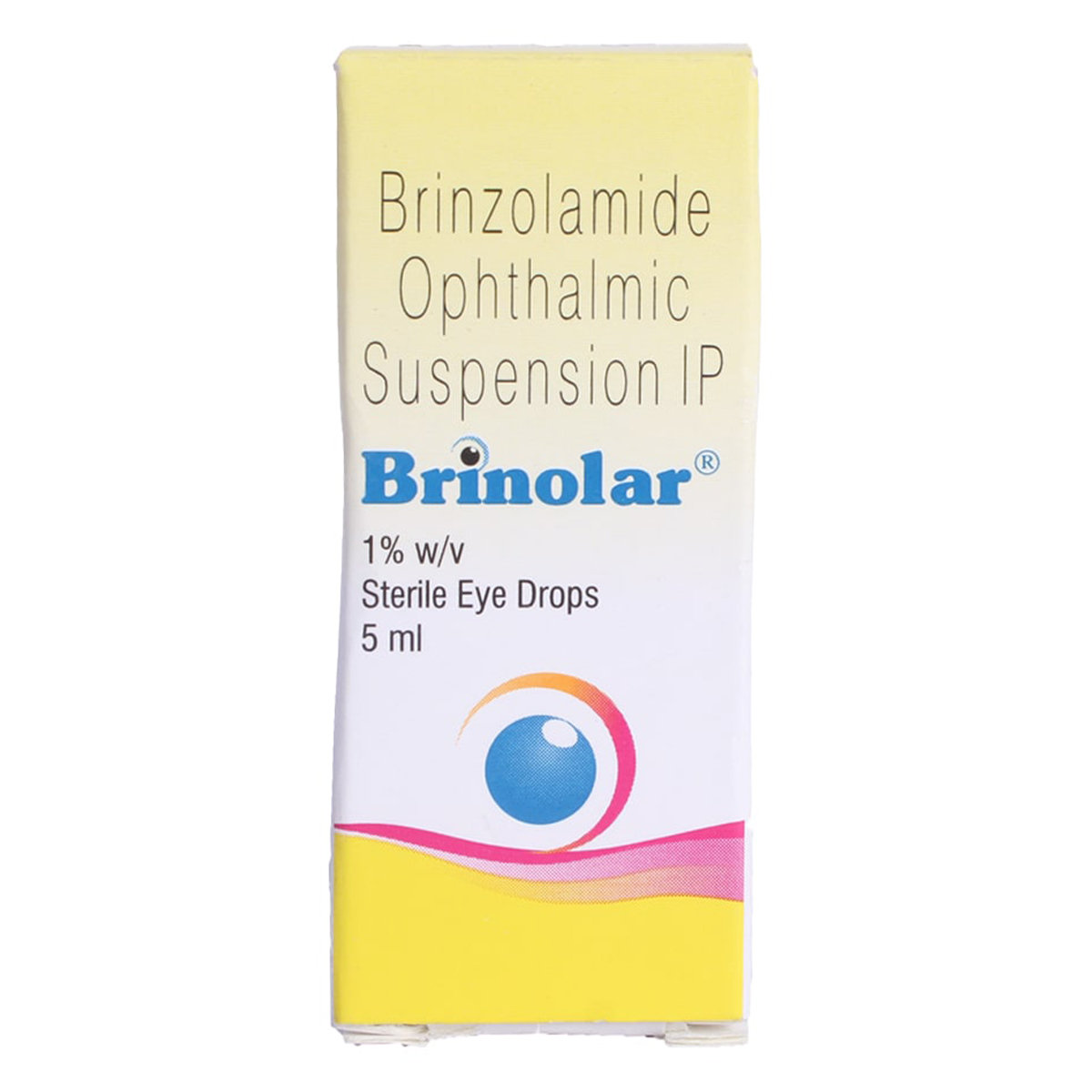Azopt Opthalmic Suspension 5 ml

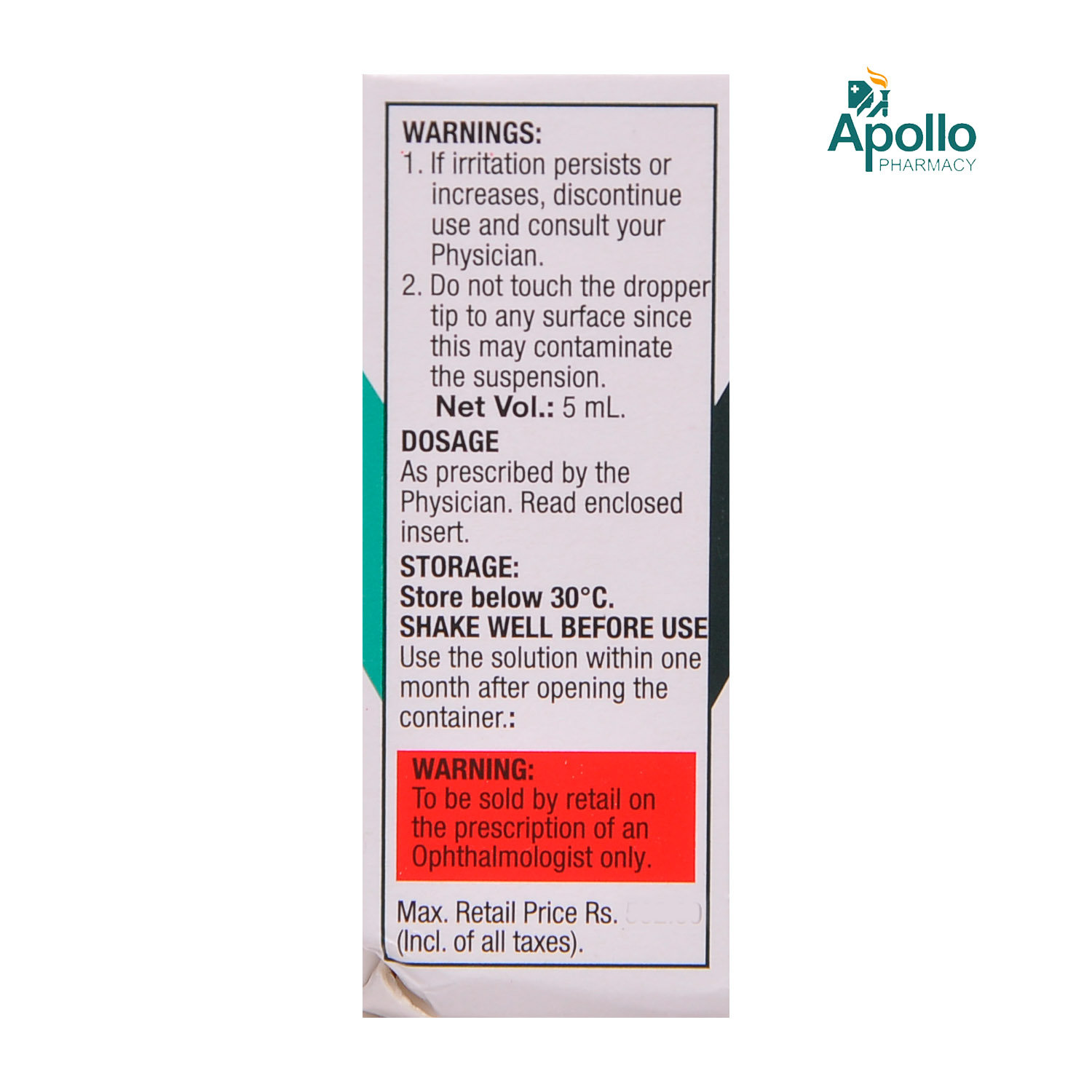
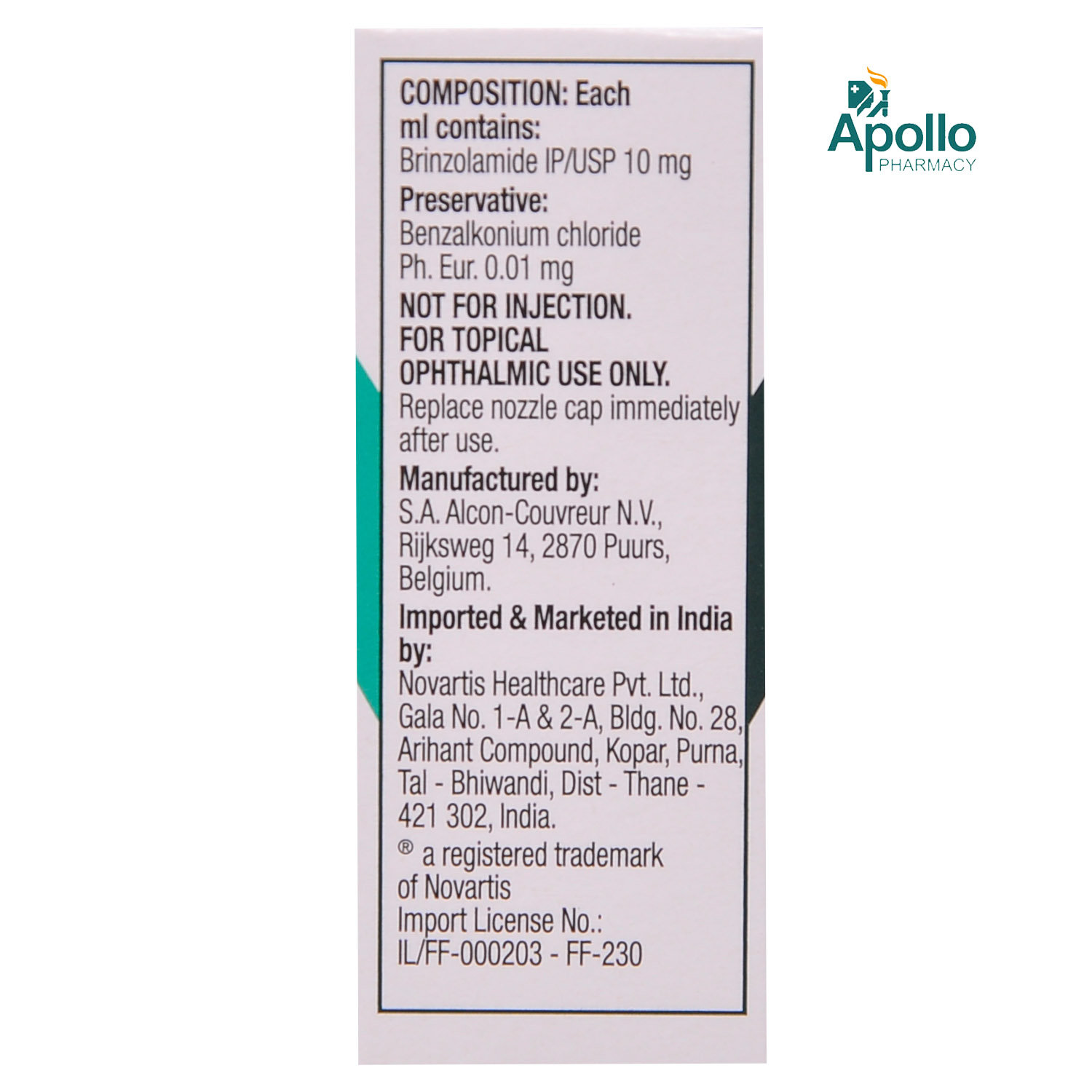
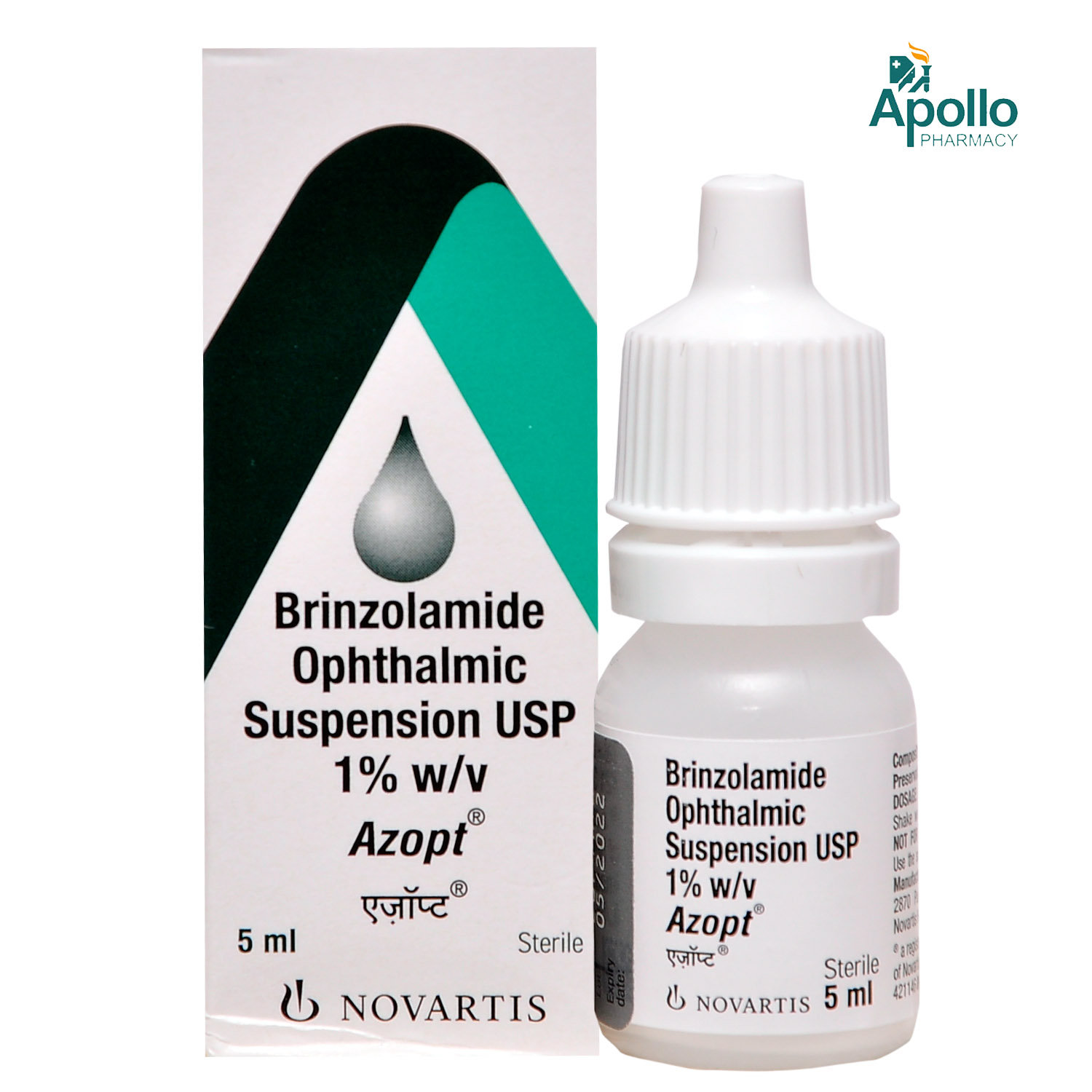
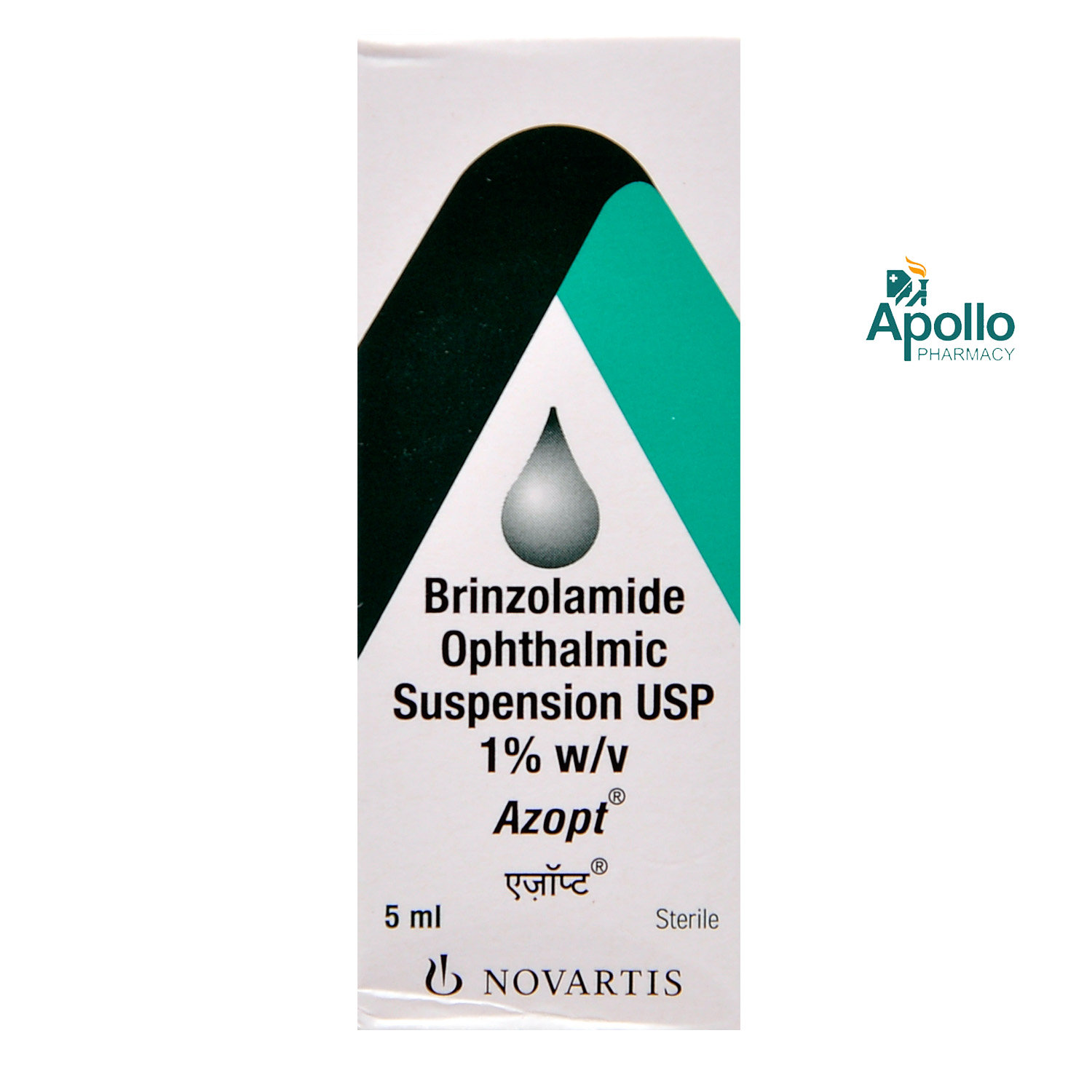



MRP ₹614
(Inclusive of all Taxes)
₹92.1 Cashback (15%)
Provide Delivery Location
Online payment accepted
 Prescription drug
Prescription drugWhats That
Composition :
Manufacturer/Marketer :
Consume Type :
Expires on or after :
Return Policy :
About Azopt Opthalmic Suspension 5 ml
Azopt Opthalmic Suspension 5 ml belongs to a class of anti-glaucoma agents called carbonic anhydrase inhibitors primarily used to treat increased pressure in eye conditions. Glaucoma is an eye condition that causes damage to the optic nerve (essential for good vision) due to abnormally increased pressure in the eye. Ocular hypertension is increased pressure in the eye due to poor drainage of aqueous humour (fluid in the eye that maintains normal pressure by its continuous flow).
Azopt Opthalmic Suspension 5 ml contains Brinzolamide which works by inhibiting the action of carbonic anhydrase enzyme and decreasing bicarbonate production essential for the production of fluid in the eye (aqueous humour). Thus it reduces the secretion of eye fluid called 'aqueous humour' that maintains pressure in the eyeball and in turn lowers the raised pressure in the eye by reducing aqueous humour entry into the eyeball. Thus, Azopt Opthalmic Suspension 5 ml prevents eyes from getting blind in the conditions of open-angle type glaucoma and ocular hypertension.
Use Azopt Opthalmic Suspension 5 ml as prescribed. Azopt Opthalmic Suspension 5 ml is only for use in the eyes. Do not swallow or inject Azopt Opthalmic Suspension 5 ml. Your doctor will advise you on how many drops to instil based on your medical condition. In some cases, you may experience eye discharge, redness, itching, irritation or pain in the eyes, blurred vision, abnormal eye sensation and dry eyes. Most of these side effects of Azopt Opthalmic Suspension 5 ml do not require medical attention and gradually resolve over time. However, if the side effects worsen or persist, please consult your doctor.
If you are allergic to Azopt Opthalmic Suspension 5 ml or any other medicines, please tell your doctor. Azopt Opthalmic Suspension 5 ml is not recommended for children below 18 years of age. You are not advised to use Azopt Opthalmic Suspension 5 ml if you are pregnant, breastfeeding or have severe kidney problems or hyperchloraemic acidosis (excessive acidity in the blood). You are advised to remove soft contact lenses before using Azopt Opthalmic Suspension 5 ml as it may cause discolouration of the soft contact lens. If you get any new eye problem, an eye infection or notice any allergic reactions such as itching or redness of the eye and skin rash, please consult your doctor immediately. You are advised to maintain a 5 minutes time gap between using Azopt Opthalmic Suspension 5 ml and other eye drops. If you have dry eyes, cornea problems, narrow-angle glaucoma, pseudoexfoliative glaucoma or pigmentary glaucoma kidney or liver problems, before taking Azopt Opthalmic Suspension 5 ml.
Uses of Azopt Opthalmic Suspension 5 ml
Directions for Use
Key Benefits
Azopt Opthalmic Suspension 5 ml contains Brinzolamide used to treat increased pressure in the eye in conditions such as glaucoma (damage of optic nerve) and ocular hypertension (high fluid pressure inside the eye). Azopt Opthalmic Suspension 5 ml inhibits the action of carbonic anhydrase enzyme and decreases bicarbonate production that is essential for the production of aqueous humour. Thereby, it reduces the secretion of aqueous humour (a liquid that maintains normal pressure in the eyeball) and lowers the pressure in the eye by reducing aqueous humour entry into the eyeball.
Storage
- Bitter or bad taste can be managed by taking Vitamin B12 supplements only after your doctor's consultation.
- Maintain good oral hygiene by using mouthwash frequently and cleaning your tongue while brushing.
- Avoid eating foods that cause heartburn or stomach pain, as they can lead to a bitter taste in your mouth.
- Do not smoke or drink alcohol, as it can worsen your condition.
- Gently wash the eyelids using mild soap with lukewarm water to wash away dirt and bacteria.
- Avoid rubbing the eyes or eyelids to prevent the inflammation.
- Keep contact lenses clean and disinfected to avoid infection.
- Follow the treatment plan and attend follow-up appointments to ensure full recovery.
- See a doctor again if changes in your vision or eye symptoms occur.
- Know your allergens that cause dermatitis and avoid them.
- Use fragrance-free detergents and soaps.
- Apply moisturizer after taking bath to retain moisture in the skin.
- Apply cool, moist compresses to the rash.
- Talk to your doctor about creams and ointments to manage your dermatitis.
- Hydrate your body: Drink enough water to prevent dehydration and headaches.
- Calm Your Mind: Deep breathing and meditation can help you relax and relieve stress.
- Rest and Recharge: Sleep for 7-8 hours to reduce headache triggers.
- Take rest: lie down in a quiet, dark environment.
- Cold or warm compresses can help reduce tension.
- Stay Upright: Maintain good posture to keep symptoms from getting worse.
- To treat headaches naturally, try acupuncture or massage therapy.
- Over-the-counter pain relievers include acetaminophen and ibuprofen.
- Prescription Assistance: Speak with your doctor about more substantial drug alternatives.
- Severe Headaches: Seek emergency medical assistance for sudden, severe headaches.
- Frequent Headaches: If you get reoccurring headaches, consult your doctor.
- Headaches with Symptoms: Seek medical attention if your headaches include fever, disorientation, or weakness.
- Excessive blood flow needs immediate medical attention it should not be ignored.
- Get an immediate physical examination and take necessary precautions.
- Avoid anxiety and stress, as it can worsen your condition.
- Consume more foods that are rich in Vitamin C and iron.
- Stay hydrated and take necessary medication to control excess bleeding, as it can lead to critical conditions.
- Wash your hands thoroughly before touching your eyes to prevent spreading the infection.
- Gently wipe away discharge from the inner corner of your eye outwards using a clean, damp washcloth.
- Apply warm compress to help loosen crusty build up and soothe irritation.
- Take diet containing vitamins, minerals and proteins for the eye health.
- Consult the doctor if the conjunctival discharge is excessive with severe pain.
Drug Warnings
If you are allergic to Azopt Opthalmic Suspension 5 ml or any other medicines, please tell your doctor. Azopt Opthalmic Suspension 5 ml is not recommended for children below 18 years of age. You are not advised to use Azopt Opthalmic Suspension 5 ml if you are pregnant, breastfeeding, or have severe kidney problems or hyperchloraemic acidosis (excessive acidity in the blood). You are advised to remove soft contact lenses before using Azopt Opthalmic Suspension 5 ml as it may cause discoloration of the soft contact lens. If you get any new eye problem, an eye infection, or notice any allergic reactions such as itching or redness of the eye and skin rash, please consult your doctor immediately. You are advised to maintain a 5 minutes time gap between using Azopt Opthalmic Suspension 5 ml and other eye drops. Please do not touch the container tip to the eye, eyelids, or surrounding areas as it may contaminate Azopt Opthalmic Suspension 5 ml and cause eye infections. If you have dry eyes, cornea problems, narrow-angle glaucoma, pseudoexfoliative glaucoma, or pigmentary glaucoma kidney or liver problems, before taking Azopt Opthalmic Suspension 5 ml.
Drug-Drug Interactions
Drug-Drug Interactions
Login/Sign Up
Taking Azopt Opthalmic Suspension 5 ml with Choline salicylate may increase the risk of side effects.
How to manage the interaction:
Although taking Azopt Opthalmic Suspension 5 ml and Choline salicylate together can result in an interaction, they can be taken together if prescribed by a doctor. However, if you experience ringing in your ears, headache, vomiting, dizziness, or palpitations, consult a doctor. Do not stop using any medications without consulting a doctor.
Concomitant use of Azopt Opthalmic Suspension 5 ml with sodium salicylate may cause ringing in the ears, nausea, vomiting, headache, dizziness, confusion, hallucinations, rapid breathing, fever, and seizure (convulsions).
How to manage the interaction:
Although there is an interaction, Azopt Opthalmic Suspension 5 ml should be used with sodium salicylate only if prescribed by the doctor. However, if you experience ringing in the ears, vomiting, headache, dizziness, or fever, contact your doctor immediately. Do not stop using any medications without consulting your doctor.
Concomitant use of Azopt Opthalmic Suspension 5 ml with salsalate can increase the risk of side effects.
How to manage the interaction:
Although there is an interaction, Azopt Opthalmic Suspension 5 ml should be used with salsalate only if prescribed by the doctor. Consult a doctor immediately if you experience ringing in the ears, vomiting, headache, dizziness, and fever. Do not stop using any medications without first talking to your doctor.
Coadministration of Azopt Opthalmic Suspension 5 ml with diflunisal can increase the risk of side effects.
How to manage the interaction:
Although there is an interaction, Azopt Opthalmic Suspension 5 ml should be used with diflunisal only if prescribed by the doctor. Consult a doctor if you experience vomiting, headache, dizziness, or fever. Do not stop using any medications without first talking to your doctor.
Coadministration of Azopt Opthalmic Suspension 5 ml with Aspirin may cause side effects.
How to manage the interaction:
Although there is a possible interaction between aspirin and Azopt Opthalmic Suspension 5 ml, you can take these medicines together if prescribed by a doctor. However, if you experience ringing in your ears, headache, vomiting, dizziness, or palpitations, please contact a doctor. Do not stop using any medications without talking to a doctor.
Drug-Food Interactions
Drug-Food Interactions
Login/Sign Up
Diet & Lifestyle Advise
- Avoid baked foods such as cakes, cookies, donuts, or fried items such as French fries and stick margarine as these foods may worsen glaucoma and damage the optic nerve.
- Please cut down your coffee intake as it may increase pressure in the eye and replace coffee with green tea.
- Avoid exercises such as any position where the head is lower than the body like inverted yoga poses as it may increase pressure in the eye. Doing selective exercises is advised for glaucoma patients.
Side Effects of Azopt Opthalmic Suspension 5 ml
- Eye discharge
- Redness, itching, irritation or pain in the eyes
- Blurred vision
- Abnormal eye sensation
- Dry eyes
Habit Forming
Therapeutic Class
All Substitutes & Brand Comparisons
RX
Brio Eye Drops 5 ml
Sunways (India) Pvt Ltd
₹234
(₹42.12/ 1ml)
61% CHEAPERRX
Out of StockBrinzodoc Eye Drop 5 ml
Lupin Ltd
₹375
(₹67.5/ 1ml)
38% CHEAPERRX
Brintod 10 Eye Drop 5 ml
Entod Pharmaceuticals Ltd
₹406.5
(₹73.18/ 1ml)
33% CHEAPER
Product Substitutes
Author Details
We provide you with authentic, trustworthy and relevant information
Drug-Diseases Interactions
Drug-Diseases Interactions
Login/Sign Up
Applying Azopt Opthalmic Suspension 5 ml ophthalmic to the skin, eyes, or mucosal membranes may cause systemic absorption. In addition to methemoglobinemia, sulfhemoglobinemia, leukopenia, granulocytopenia, eosinophilia, hemolytic anaemia, aplastic anaemia, purpura, coagulation problem, thrombocytopenia, hypofibrinogenemia, and hypoprothrombinemia, the usage of sulfonamides has also been linked to hematologic damage. Patients who already have blood dyscrasias or marrow suppression should use topical sulfonamide therapy with caution. During prolonged therapy (>2 weeks), complete blood counts should be taken on a regular basis, and patients should be instructed to report any indications or symptoms of a blood dyscrasia right away, such as fever, sore throat, local infection, bleeding, pallor, dizziness, or jaundice.
How to manage the interaction:
Azopt Opthalmic Suspension 5 ml should be administered cautiously in patients with preexisting blood problems or bone marrow suppression. Complete blood count tests are advised regularly during prolonged therapy (>2 weeks). Consult the doctor if you notice signs or symptoms of blood problems such as fever, sore throat, local infection, bleeding, dizziness, or jaundice.
When sulfonamides are administered to the skin, eye, or mucosal membranes, they may be absorbed systemically. Patients with porphyria should use topical sulfonamide therapy with caution because these medications can cause an acute attack. Patients with porphyria are thought to be contraindicated for oral sulfonamide usage.
How to manage the interaction:
Therapy should be administered cautiously in patients with porphyria, since it may precipitate an acute attack.
When sulfonamides are administered to the skin, eye, or mucosal membranes, they may be absorbed systemically. Due to the sulfonamide and/or its N4-acetyl metabolite precipitating in the urinary tract, the usage of sulfonamides has been linked to crystalluria. There have been reports of renal toxicity, including hematuria, proteinuria, increased BUN and creatinine, uro- and nephrolithiasis, nephritis, toxic nephrosis, and more. During the use of sulfonamides, hydration and sufficient urine output (> 1.5 L/day) should be maintained. Patients who are dehydrated (for instance, as a result of severe diarrhoea or vomiting) may be more vulnerable to developing crystalluria and lithiasis, thus they should be encouraged to drink more liquids.
How to manage the interaction:
Dehydrated patients may be at increased risk for the development of crystalluria and lithiasis (formation of stones). Therefore, consume additional amounts of liquid. Hydration and adequate urinary output (> 1.5 L/day) should be maintained during administration of the medicine. Renal function tests and urinalysis should be performed regularly during prolonged therapy (> 2 weeks).
Rarely have individuals using sulfonamides reported experiencing hepatotoxicity, including jaundice, diffuse hepatocellular necrosis, hypersensitivity hepatitis, and hepatic failure.
How to manage the interaction:
Therapy should be administered cautiously in patients with liver disease.
Sulfonamide side effects may be more likely to occur in those with renal impairment because of decreased medication clearance. Sulfonamides can also result in toxic nephrosis, hematuria, proteinuria, increased BUN, and creatinine levels in addition to renal damage related to crystalluria.
How to manage the interaction:
Hydration and adequate urinary output (> 1.5 L/day) should be maintained during administration of the medicine in patients with kidney dysfunction. Renal function tests and urinalysis should be performed regularly during prolonged therapy (> 2 weeks).
When sulfonamides are administered to the skin, eye, or mucosal membranes, they may be absorbed systemically. Hematologic toxicity has been linked to the usage of sulfonamides.
How to manage the interaction:
A urinary output of at least 1.5 L/day should be maintained during therapy. Renal function tests and urinalysis should be performed regularly during prolonged therapy (> 2 weeks).
FAQs
Azopt Opthalmic Suspension 5 ml contains Brinzolamide that works by inhibiting the action of carbonic anhydrase enzyme and decreases bicarbonate production that is essential for the production of aqueous humour. Thereby, it reduces the secretion of aqueous humour (a liquid that maintains normal pressure in the eyeball) and lowers the pressure in the eye by reducing aqueous humour entry into the eyeball.
You are recommended to wash your hands first and tilt your head back and gently pull the lower eyelid downwards. Then, press the bottom of the bottle gently by holding it upside down to instil one drop into the affected eye without touching the tip of the bottle to the eye or surrounding areas in order to avoid contamination. Finally, replace the cap tightly after use. After applying Azopt Opthalmic Suspension 5 ml, you are advised to apply to the corner of the eye by pressing a finger to stop eye drops from spreading into the rest of the body.
No, you are not recommended to wear contact lenses while using Azopt Opthalmic Suspension 5 ml as it contains benzalkonium chloride, a preservative that changes the colour of the contact lens as it may be absorbed by a soft contact lens. Benzalkonium chloride also causes irritation in the eye especially if you have disorders of the cornea (transparent layer at the front of the eye) or dry eyes. Therefore, you are advised to remove contact lenses before applying Azopt Opthalmic Suspension 5 ml and reinsert after 15 minutes of using Azopt Opthalmic Suspension 5 ml. Also, inform your doctor if you experience pain, stinging or abnormal sensation in the eye after using Azopt Opthalmic Suspension 5 ml.
You are recommended to maintain a minimum of 5 minutes time gap between using Azopt Opthalmic Suspension 5 ml and other eye drops and administer eye ointments in the last.
Yes, Azopt Opthalmic Suspension 5 ml may cause temporary blurred vision. Therefore, you are recommended to wait until your vision is clear before driving or operating heavy machinery.
You are not recommended to stop using Azopt Opthalmic Suspension 5 ml without consulting your doctor as it may increase pressure in the eyes and may lead to loss of vision. Therefore, use Azopt Opthalmic Suspension 5 ml for as long as your doctor has prescribed it, and if you experience any difficulty while taking Azopt Opthalmic Suspension 5 ml, please consult your doctor.
Drug-Drug Interactions Checker List
- DORZOLAMIDE
- ACETAZOLAMIDE
Special Advise
- You are recommended to avoid wearing contact lenses while using Azopt Opthalmic Suspension 5 ml as it may cause discoloration of soft contact lenses.
- Do not use Azopt Opthalmic Suspension 5 ml if you have used any steroid eye injection within six months, undergone any other intraocular surgery (like cataract surgery) within 6 months, or have had any laser surgery within 12 months.
Disease/Condition Glossary
Glaucoma: It is an eye condition that causes damage to the optic nerve (essential for good vision) due to abnormally increased pressure in the eye. If it is not treated in time, it may cause blindness. Usually, there are no symptoms of glaucoma initially except the slow loss of vision gradually. However, some symptoms include visible rainbow-colored circles around bright lights or blurred vision. Rarely, glaucoma can develop suddenly with intense pain in the eye, visual disturbance, or nausea.
Ocular hypertension: It is a condition caused due to poor drainage of aqueous humor (fluid in the eye that maintains normal pressure by its continuous flow). This leads to the build-up of excess fluid in the eye resulting in increased pressure inside the eye without any damage to the optic nerve. If ocular hypertension is not controlled, it may lead to glaucoma.

Have a query?
Buy best Ocular products by
Entod Pharmaceuticals Ltd
Ajanta Pharma Ltd
Sunways (India) Pvt Ltd
Sun Pharmaceutical Industries Ltd
Cipla Ltd
Micro Labs Ltd
Allergan Healthcare India Pvt Ltd
Intas Pharmaceuticals Ltd
Raymed Pharmaceuticals Ltd
Nri Vision Care India Ltd
FDC Ltd
Jawa Pharmaceuticals India Pvt Ltd
Indoco Remedies Ltd
Sapient Laboratories Pvt Ltd
Senses Pharmaceuticals Pvt Ltd
Centaur Pharmaceuticals Pvt Ltd
Neomedix Healthcare India Pvt Ltd
Aromed Pharmaceuticals
Optho Remedies Pvt Ltd
Aurolab
Austrak Pvt Ltd
Lupin Ltd
Mankind Pharma Pvt Ltd
Zivira Labs Pvt Ltd
Optho Pharma Pvt Ltd
Synovia Life Sciences Pvt Ltd
Akumentis Healthcare Ltd
Eyekare
His Eyeness Ophthalmics Pvt Ltd
Protech Remedies Pvt Ltd
Runyon Pharmaceutical Pvt Ltd
Alcon Laboratories Inc
Syntho Pharmaceuticals Pvt Ltd
Alembic Pharmaceuticals Ltd
Bell Pharma Pvt Ltd
Klar Sehen Pvt Ltd
Sentiss Pharma Pvt Ltd
Irx Pharmaceuticals Pvt Ltd
Optho Life Sciences Pvt Ltd
Phoenix Remedies Pvt Ltd
Alkem Laboratories Ltd
Doctor Wonder Pvt Ltd
Hicare Pharma
Ipca Laboratories Ltd
Neon Laboratories Ltd
Okulus Drugs India
Pharmtak Ophthalmics (I) Pvt Ltd
Berry & Herbs Pharma Pvt Ltd
Glow Vision Pharmaceuticals
Kaizen Drugs Pvt Ltd
Choroid Laboratories Pvt Ltd
Indiana Opthalamics Pvt Ltd
Optica Pharmaceutical Pvt Ltd
Pharmatak Opthalmics India Pvt Ltd
Samarth Life Sciences Pvt Ltd
Vibgyor Vision Care
Mofon Drugs
Novartis India Ltd
Pharmia Biogenesis Pvt Ltd
Zydus Cadila
Appasamy Ocular Devices Pvt Ltd
Leeford Healthcare Ltd
Medivision Pharma Pvt Ltd
Orbit Life Science Pvt Ltd
X-Med Royal Pharma Pvt Ltd
Zee Laboratories Ltd
Aarma Laboratories
Guerison MS Inc
Laborate Pharmaceuticals India Ltd
Xtas Pharmaceuticals
Accurex Biomedical Pvt Ltd
Blucrab Pharma Pvt Ltd
Does Health Systems Pvt Ltd
Flagship Biotech International Pvt Ltd
Lavue Pharmaceuticals Pvt Ltd
Nutrilis Healthcare Pvt Ltd
Ursa Pharm India Pvt Ltd
Vee Remedies
Vyonics Health Care India Pvt Ltd
Warren Pharmaceuticals Pvt Ltd
Abbott India Ltd
Accvus Pharmaceuticals
Akums Drugs & Pharmaceuticals Ltd
Cadila Healthcare Ltd
Carevision Pharmaceuticals Pvt Ltd
Dey's Medical Stores (Mfg) Ltd
East West Pharma India Pvt Ltd
Eyedea Pharmaceuticals Pvt Ltd
Nimbus Healthcare Pvt Ltd
Ocuris Pharmaceuticals Pvt Ltd
Sherings Pharmaceuticals
Tarks Pharmaceuticals Pvt Ltd
Vcan Biotech
Vision Medilink
Aice Health Care Pvt Ltd
Appasamy Pharmaceuticals Pvt Ltd
Asperia Lifescience Pvt Ltd
Beatum Healthcare Pvt Ltd
East India Pharmaceutical Works Ltd
Grevis Pharmaceutical Pvt Ltd
Alcohol
Safe if prescribed
The interaction of alcohol with Azopt Opthalmic Suspension 5 ml is unknown. Please consult a doctor before consuming alcohol with Azopt Opthalmic Suspension 5 ml.
Pregnancy
Consult your doctor
Azopt Opthalmic Suspension 5 ml is a Category C pregnancy drug and is not recommended for use during pregnancy unless your doctor considers it essential.
Breast Feeding
Consult your doctor
Avoid breastfeeding while taking Azopt Opthalmic Suspension 5 ml. Please consult a doctor before using Azopt Opthalmic Suspension 5 ml in breastfeeding mothers.
Driving
Safe if prescribed
Azopt Opthalmic Suspension 5 ml may cause blurred vision in some people. So, drive only when your vision is clear after taking Azopt Opthalmic Suspension 5 ml.
Liver
Consult your doctor
If you have any concerns regarding the use of Azopt Opthalmic Suspension 5 ml in patients with liver problems, please consult a doctor.
Kidney
Consult your doctor
If you have any concerns regarding the use of Azopt Opthalmic Suspension 5 ml in patients with kidney problems, please consult a doctor.
Children
Safe if prescribed
Azopt Opthalmic Suspension 5 ml is not recommended for children below 18 years of age, as the safety and effectiveness were not established.


